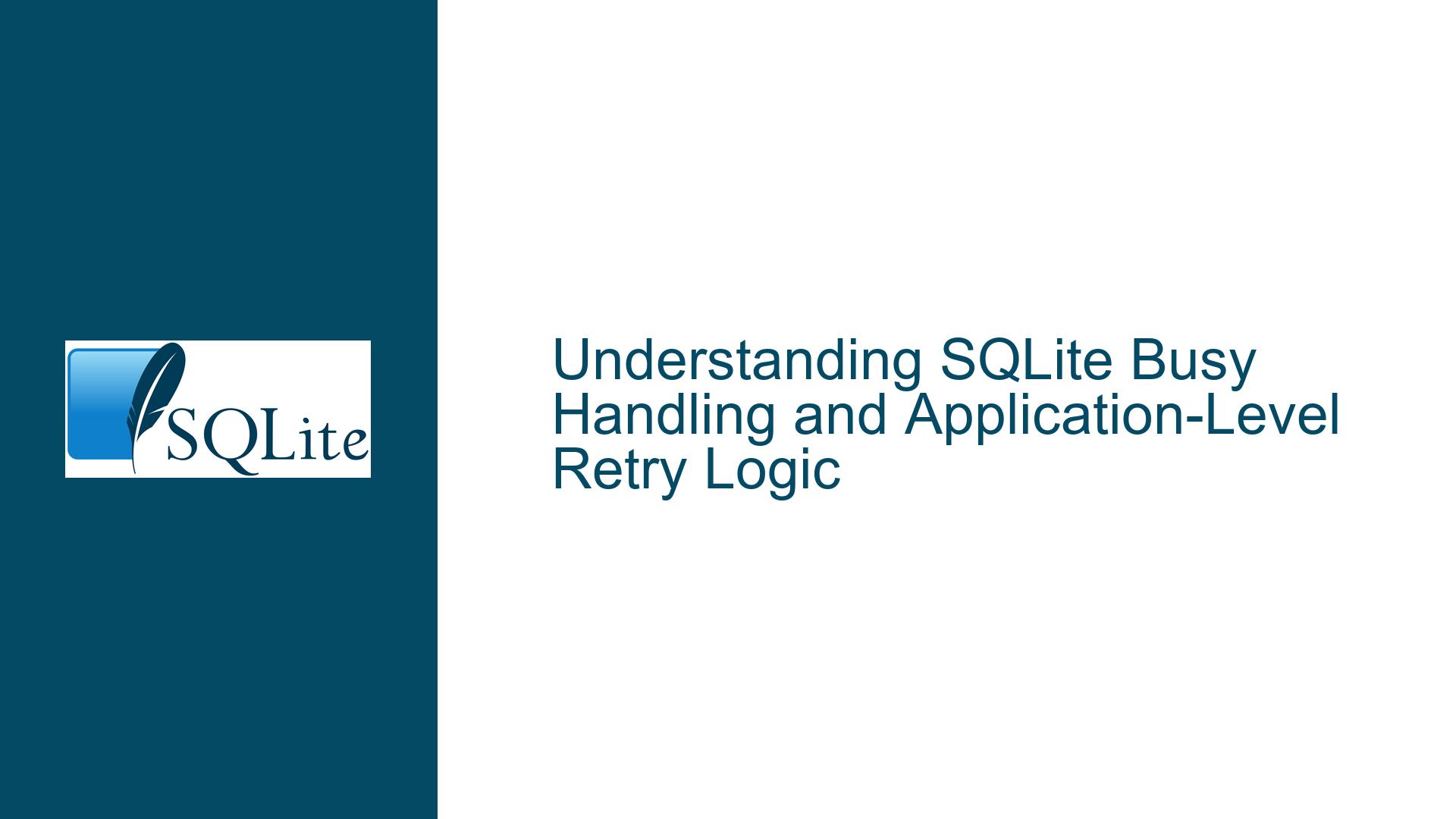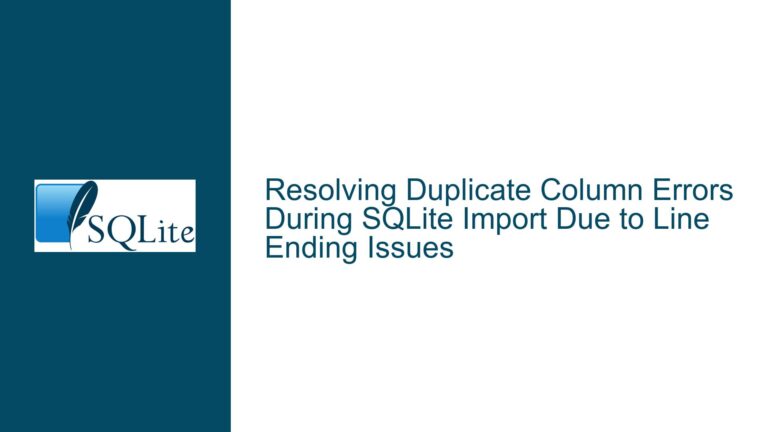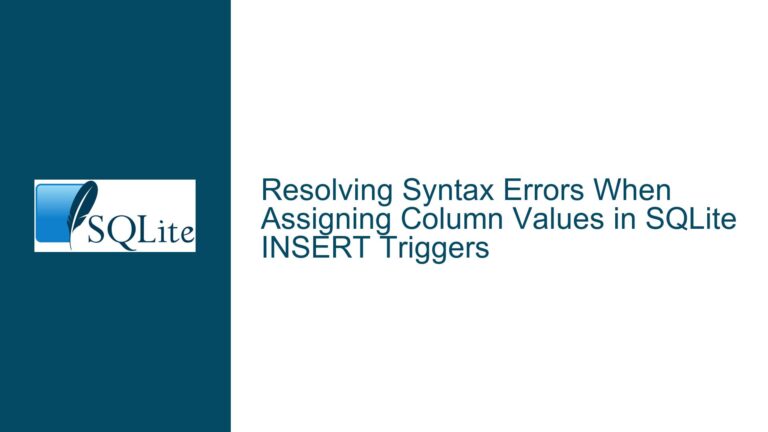SQLite Busy Handling and Application-Level Retry Logic
SQLite Busy Handling and Application-Level Retry Logic: A Deep Dive
Issue Overview: The Interplay Between SQLite’s Busy Handler and Application-Level Retry Mechanisms
When working with SQLite in a concurrent environment, particularly in scenarios involving multiple write operations, handling database locks effectively is crucial. SQLite provides a built-in mechanism known as the "busy handler" to manage situations where a database operation cannot proceed due to a lock. The busy handler can be configured to retry the operation for a specified duration (busy_timeout) before giving up and returning an SQLITE_BUSY error. However, the behavior of the busy handler, especially when combined with application-level retry logic, can be nuanced and sometimes confusing.
In the context of PHP using PDO (PHP Data Objects) with SQLite, the busy handler is set via the ATTR_TIMEOUT attribute, which defines the maximum time (in seconds) that SQLite should wait for a lock to be released before returning an SQLITE_BUSY error. The default value for this timeout is 60 seconds, which can be problematic in high-concurrency environments or when the database is hosted on a network file system (NFS) like AWS EFS, where latency and availability issues can exacerbate lock contention.
The core issue arises when developers implement their own retry logic at the application level, in addition to relying on SQLite’s built-in busy handler. The question is whether this application-level retry logic is redundant or even dangerous, given that the busy handler already retries operations internally. Furthermore, there is confusion about how the busy handler behaves—whether it retries continuously or simply waits for the specified timeout period before giving up.
Possible Causes: Why Application-Level Retry Logic Might Be Necessary
The need for application-level retry logic stems from several factors, including the limitations of SQLite’s busy handler, the nature of the database operations, and the environment in which the database is hosted.
1. Limitations of SQLite’s Busy Handler:
SQLite’s busy handler is designed to handle transient lock situations by retrying the operation for a specified duration. However, it does not handle all possible lock scenarios. For instance, in cases of deadlocks or when a COMMIT operation encounters an SQLITE_BUSY error, the busy handler may not be sufficient. According to SQLite’s documentation, there are rare scenarios where a COMMIT operation can still encounter an SQLITE_BUSY error, even after the busy handler has retried the operation. In such cases, the application must roll back the transaction and retry the operation from the beginning.
2. Nature of Database Operations:
The nature of the database operations being performed can also influence the need for application-level retry logic. For example, if the application is performing a series of INSERT, UPDATE, or DELETE operations within a transaction, the likelihood of encountering a lock increases, especially in high-concurrency environments. In such cases, relying solely on SQLite’s busy handler may not be sufficient, as the handler may not be able to resolve the lock situation within the specified timeout period.
3. Environment-Specific Factors:
The environment in which the database is hosted can also play a significant role in determining the need for application-level retry logic. For instance, if the database is hosted on a network file system (NFS) like AWS EFS, latency and availability issues can exacerbate lock contention. In such environments, the busy handler may not be able to resolve lock situations effectively, leading to the need for additional retry logic at the application level.
4. Misconfiguration of Busy Timeout:
Another potential cause of issues is the misconfiguration of the busy timeout. If the busy timeout is set too high, the application may experience long delays before an SQLITE_BUSY error is returned, leading to poor user experience and potential timeouts at the HTTP level. Conversely, if the busy timeout is set too low, the busy handler may not have enough time to resolve the lock situation, leading to unnecessary retries at the application level.
Troubleshooting Steps, Solutions & Fixes: Optimizing SQLite Lock Handling in PHP with PDO
To address the issues related to SQLite’s busy handler and application-level retry logic, several steps can be taken to optimize the handling of database locks in PHP with PDO.
1. Understanding the Behavior of SQLite’s Busy Handler:
The first step in troubleshooting is to understand how SQLite’s busy handler behaves. The busy handler is designed to retry the operation for a specified duration (busy_timeout) before returning an SQLITE_BUSY error. However, it is important to note that the busy handler does not retry continuously; instead, it waits for the lock to be released and retries the operation at intervals. The exact behavior of the busy handler can vary depending on the implementation in the specific language or library being used (e.g., PHP’s PDO).
In PHP with PDO, the busy handler is set via the ATTR_TIMEOUT attribute, which defines the maximum time (in seconds) that SQLite should wait for a lock to be released before returning an SQLITE_BUSY error. The default value for this timeout is 60 seconds, which can be adjusted based on the specific requirements of the application.
2. Implementing Application-Level Retry Logic:
Given the limitations of SQLite’s busy handler, it is often necessary to implement additional retry logic at the application level. This retry logic should be designed to handle scenarios where the busy handler is unable to resolve the lock situation, such as in cases of deadlocks or when a COMMIT operation encounters an SQLITE_BUSY error.
The application-level retry logic should include the following steps:
- Catch SQLITE_BUSY Errors: The application should catch SQLITE_BUSY errors and handle them appropriately. This may involve rolling back the current transaction, releasing all locks, and retrying the operation from the beginning.
- Set a Reasonable Retry Delay: When retrying the operation, the application should set a reasonable delay between retries to avoid overwhelming the database with repeated requests. This delay can be implemented using the
usleepfunction in PHP, which pauses the execution of the script for a specified number of microseconds. - Limit the Number of Retries: The application should limit the number of retries to avoid infinite loops in cases where the lock situation cannot be resolved. This can be implemented using a counter that tracks the number of retries and exits the loop after a specified number of attempts.
3. Configuring the Busy Timeout Appropriately:
The busy timeout should be configured based on the specific requirements of the application and the environment in which the database is hosted. In general, the busy timeout should be set to a value that allows the busy handler to resolve most lock situations without causing excessive delays.
For example, if the database is hosted on a network file system (NFS) like AWS EFS, where latency and availability issues can exacerbate lock contention, the busy timeout should be set to a lower value to avoid long delays. Conversely, if the database is hosted on a local file system with low latency, the busy timeout can be set to a higher value to allow the busy handler more time to resolve lock situations.
4. Monitoring and Logging:
To gain better visibility into the behavior of the busy handler and the application-level retry logic, it is important to implement monitoring and logging. This can help identify patterns in lock contention and determine whether the busy timeout and retry logic are configured appropriately.
For example, the application can log the number of retries, the duration of each retry, and the outcome of each retry attempt. This information can be used to fine-tune the busy timeout and retry logic, as well as to identify potential issues with the database environment.
5. Handling Deadlocks and COMMIT Failures:
In cases where a COMMIT operation encounters an SQLITE_BUSY error, the application should handle the situation by rolling back the transaction and retrying the operation from the beginning. This is because, in such scenarios, the busy handler may not be able to resolve the lock situation, and the application must take corrective action to avoid data corruption or inconsistencies.
The application should also handle deadlocks by rolling back the current transaction, releasing all locks, and retrying the operation from the beginning. Deadlocks can occur when two or more transactions are waiting for each other to release locks, resulting in a situation where neither transaction can proceed. By rolling back the transaction and retrying the operation, the application can break the deadlock and allow the transactions to proceed.
6. Avoiding Reentrant Behavior:
When implementing application-level retry logic, it is important to avoid reentrant behavior, where the retry logic modifies the database connection that invoked the busy handler. According to SQLite’s documentation, the busy handler should not take any actions that modify the database connection, as this can result in undefined behavior.
To avoid reentrant behavior, the application should ensure that the retry logic does not modify the database connection or any associated SQLite statements. This can be achieved by creating a new database connection for each retry attempt, rather than reusing the same connection.
7. Testing and Validation:
Finally, it is important to thoroughly test and validate the busy handler and application-level retry logic to ensure that they work as expected in all scenarios. This includes testing the behavior of the busy handler under different lock contention scenarios, as well as testing the application-level retry logic in cases where the busy handler is unable to resolve the lock situation.
Testing should also include scenarios where the database is hosted on a network file system (NFS) like AWS EFS, where latency and availability issues can exacerbate lock contention. By testing in these environments, the application can ensure that the busy handler and retry logic are configured appropriately and can handle lock situations effectively.
Conclusion
In conclusion, while SQLite’s busy handler provides a useful mechanism for handling transient lock situations, it is often necessary to implement additional retry logic at the application level to handle more complex scenarios, such as deadlocks and COMMIT failures. By understanding the behavior of the busy handler, configuring the busy timeout appropriately, and implementing robust application-level retry logic, developers can optimize the handling of database locks in PHP with PDO and ensure that their applications perform reliably in high-concurrency environments. Additionally, monitoring and logging can provide valuable insights into the behavior of the busy handler and retry logic, helping developers fine-tune their configurations and identify potential issues.






